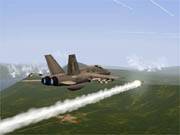F/A-18 Precision Strike Fighter is a good flight sim for its time. The problem is that its time is four years past. For all intents and purposes, this is the same exact game that Graphic Simulations released in 1997 as F/A-18 Korea. The publishers at Xicat Interactive have put it in a new box, priced it as a new game, and put it on retail shelves next to the new releases. But there's virtually nothing new about Precision Strike Fighter. What's worse, there's very little indication that you're getting recycled material. It is a rip-off of startling proportion.

Precision Strike Fighter models the F/A-18 Hornet, a carrier-based fighter plane with considerable ground attack capability. It's designed to sling lots of advanced ordnance under its wings and still fend for itself if it's jumped by enemy aircraft. It can protect its carrier by intercepting bombers or run interference for ground strike flights by taking out hostile air defenses. It's a good-looking, flexible plane that's gotten good press with appearances in movies like The Rock and Independence Day. Naturally, any self-respecting flight-sim enthusiast would want to fly one.
In 1997, F/A-18 Korea, the original incarnation of Precision Strike Fighter, was the latest in a line of Hornet sims from Graphic Simulations. Although it never enjoyed the publishing muscle of Microprose's Falcon or Electronic Arts' Jane's series, it was a solid sim that was widely appreciated by fans of the genre. It used a fast engine that looked good by 1997 standards, and it struck a nice balance between playability and realism.
Since F/A-18 Korea featured 3D acceleration using Glide only, many contemporary video cards will have problems running it in anything but the intolerably ugly software mode. So the most significant addition to Precision Strike Fighter is its OpenGL support, which lets it run on a wider range of video cards and gives it some sharp 3D-accelerated textures. Oceans ripple, detailed jets gleam in the sun, and dappled green forests cover the terrain like a plush carpet. There are also new volumetric clouds and transparency effects for explosions and smoke. Considering its age, Precision Strike Fighter could have looked a lot worse. It wears its facelift well.
But the rest of this sim is entirely identical to its predecessor, right down to important file sizes and dates. The core of this game is still a low polygon count graphics engine, which was clearly built for slower processors from a time before 3D accelerators. Most objects have a rough-hewn blocky look, as if they were whittled from wood. You get pyramids instead of rolling hills and boxes instead of buildings. The upside to this is that the game plays fast and smooth even on lower-end computers. If frame rate is important to you--and if you're really a flight-sim fanatic--then you know frame rate is king. Precision Strike Fighter is a nostalgic throwback to the days of polygonal simplicity, when sims ran fast and the terrain cut the sky in clear lines.
To its credit, Precision Strike Fighter does a good job of streamlining the jet's advanced capability without dumbing it down too much. The flight model is geared toward realism with only a few noticeable exceptions. The physics of landing and taxiing are right out of a Warner Bros. cartoon, and the rudder jerks the plane around as if it were dangling from a rubber band. But otherwise, there's enough fidelity here to put Precision Strike Fighter in the same category as serious hard-core sims.
The avionics (radar, weapons guidance, navigation, and so on) are downright arcadelike compared with Jane's latest superrealistic F/A-18 sim, but they're easy to use without making you feel superfluous--you still get a sense for having to manage a real pilot's workload. Precision Strike Fighter also does a good job of modeling the various types of weapons available for the Hornet, including a tactical nuclear warhead that goes off with a polygonal whimper. Although the sloppy mushroom cloud graphics might be considered a conscious effort not to glorify something so controversial, it's more likely this is just another lazy shortcut to shoehorn an old game into new clothes.
Considering the flight model and avionics, Precision Strike Fighter is a perfect example of a midlevel sim that treats its audience and its subject matter with respect. Although the learning curve is moderately steep, there's a series of thorough and informative tutorials. These are presented with footage from the game and a narrator who speaks with all the enthusiasm of Ben Stein doing a Visine commercial. The original game's superlative manual is presented in an abridged format, but it's still miles and away better than what you get in most games these days. The playback feature is also an excellent training tool.

Finally, there is one more thing new to Precision Strike Fighter, but it's not due to Xicat's efforts. Since F/A-18 and Precision Strike Fighter use the same scenario editor, they can run the same scenarios. So the CD includes dozens of user-made missions that were previously available on the Internet. Some of these are silly and some are sloppy, but most are slickly made and thoughtful, including some strung together in a campaign structure. Playing these scenarios offers a vivid look at the devoted fan base that F/A-18 Korea managed to create. This happens to be the same fan base that will be bitterly disappointed when it finds there's nothing new here.
There's nothing in this box you wouldn't typically find in a patch. OpenGL support and a bunch of user-made missions previously posted to the Internet do not make a new game. Precision Strike Fighter belongs in the bargain bins. But with so few flight sims on the shelves, a lot of gamers might not know any better. So by charging full price for this sorry excuse for a new product, Xicat Interactive is basically attending the funeral for flight sims so that it can pick the mourners' pockets.